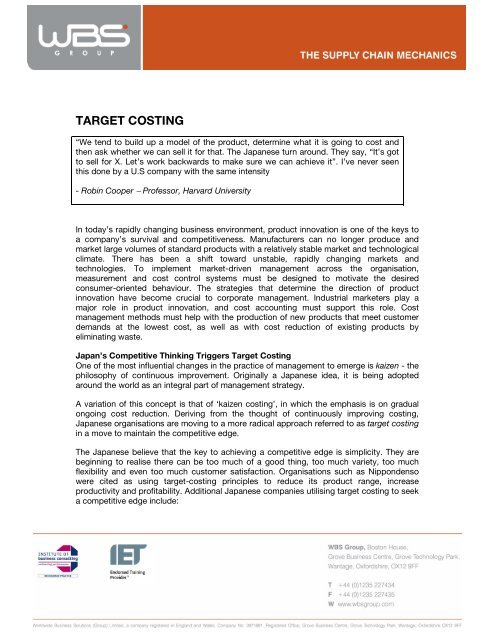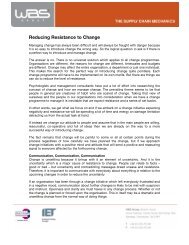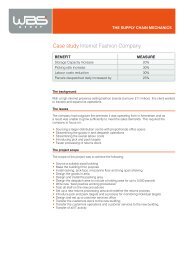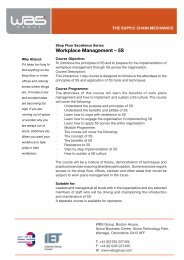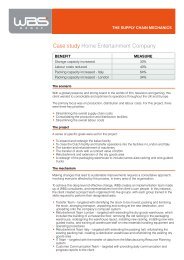TARGET COSTING - WBS Group
TARGET COSTING - WBS Group
TARGET COSTING - WBS Group
You also want an ePaper? Increase the reach of your titles
YUMPU automatically turns print PDFs into web optimized ePapers that Google loves.
<strong>TARGET</strong> <strong>COSTING</strong><br />
“We tend to build up a model of the product, determine what it is going to cost and<br />
then ask whether we can sell it for that. The Japanese turn around. They say, “It’s got<br />
to sell for X. Let’s work backwards to make sure we can achieve it”. I’ve never seen<br />
this done by a U.S company with the same intensity<br />
- Robin Cooper − Professor, Harvard University<br />
In today’s rapidly changing business environment, product innovation is one of the keys to<br />
a company’s survival and competitiveness. Manufacturers can no longer produce and<br />
market large volumes of standard products with a relatively stable market and technological<br />
climate. There has been a shift toward unstable, rapidly changing markets and<br />
technologies. To implement market-driven management across the organisation,<br />
measurement and cost control systems must be designed to motivate the desired<br />
consumer-oriented behaviour. The strategies that determine the direction of product<br />
innovation have become crucial to corporate management. Industrial marketers play a<br />
major role in product innovation, and cost accounting must support this role. Cost<br />
management methods must help with the production of new products that meet customer<br />
demands at the lowest cost, as well as with cost reduction of existing products by<br />
eliminating waste.<br />
Japan’s Competitive Thinking Triggers Target Costing<br />
One of the most influential changes in the practice of management to emerge is kaizen - the<br />
philosophy of continuous improvement. Originally a Japanese idea, it is being adopted<br />
around the world as an integral part of management strategy.<br />
A variation of this concept is that of ‘kaizen costing’, in which the emphasis is on gradual<br />
ongoing cost reduction. Deriving from the thought of continuously improving costing,<br />
Japanese organisations are moving to a more radical approach referred to as target costing<br />
in a move to maintain the competitive edge.<br />
The Japanese believe that the key to achieving a competitive edge is simplicity. They are<br />
beginning to realise there can be too much of a good thing, too much variety, too much<br />
flexibility and even too much customer satisfaction. Organisations such as Nippondenso<br />
were cited as using target-costing principles to reduce its product range, increase<br />
productivity and profitability. Additional Japanese companies utilising target costing to seek<br />
a competitive edge include:
Isuzu Motors<br />
Toyota Motor Corporation<br />
NEC<br />
Sony<br />
Sharp<br />
Nissan<br />
Target costing, although its concept is used throughout the product life cycle, is primarily<br />
used and most effective in the product development and design stage. Born out of the<br />
market-driven philosophy, target costing is based on the price-down, cost-down strategy,<br />
which has allowed companies to win considerable share of their respective markets.<br />
In companies where target costing is used, there seems to be a different culture and<br />
attitude. They place more emphasis on their relative position in the market and product<br />
leadership. Since more than 80% of product cost is already determined by the time product<br />
design and processing is complete, cost management must start (and done substantially) at<br />
the design stage.<br />
What is Target Costing?<br />
There is no clear definition to target costing. Organisations that have implemented it have<br />
had to apply their own unique approach to the concept. In essence, it is a philosophy in<br />
which product development is based on what the market will pay for it, not on what it has<br />
cost to produce. In other words, market price becomes the determinant of cost and not the<br />
other way around, as is the practice with most organisations.<br />
Target costing is a strategic management tool that seeks to reduce a product’s cost over its<br />
lifetime. Therefore, the target cost is not necessarily the cost to currently build the product.<br />
Target costing presumes interaction between cost accounting and the rest of the firm; wellexecuted,<br />
long-range profit planning; and a commitment to continuous cost reduction. Its<br />
application in Japan has been well documented, but Western World firms also can use it to<br />
understand costs better and to enhance long-term profitability.<br />
Breaking the Corporate Western World Mindset<br />
Typically, Western World manufacturers have said: Here is my cost (Amount X). I have to<br />
receive a certain profit contribution rate above that, so that consequently I must sell my<br />
product for this price (Amount Y or X/1-needed profit margin). Target costing reverses<br />
several decades of Western World pricing strategy by taking into account that our<br />
customers do not care about our costs-only about their own. Our selling price is their cost,<br />
and there the customer’s concern ends.
Traditional Costing<br />
Before target costing is addressed further, it is necessary to understand the current state<br />
for the majority of Western World firms. The traditional costing approach has the<br />
management accountant contributing only as a cost accountant, working with historical<br />
information and subsequent to many significant decisions, which have already been made.<br />
The management accountant may then provide information that in today’s competitive<br />
environment triggers an after-the-fact response, often too late to contribute cost savings<br />
value to the company.<br />
In the traditional model of costing, costs are the driver. As costs increase, prices are<br />
increased to sustain profit margins. Tried, but determined to not be so true, traditional<br />
costing abides by the following steps:<br />
Assess market needs<br />
Evaluate competing products<br />
Develop new products<br />
Decide whether to make or buy products or components<br />
Calculate how much to invest in new processes<br />
Set up new processes<br />
Manufacture new products<br />
Cost products<br />
Set price<br />
The Process of Implementation - Target Costing into a New Product<br />
The target costing approach brings the management accountant into the process at the<br />
early planning stage. The management accountant is contributing to the early decisions—<br />
should the company be making this kind of product? What constraints need to be applied<br />
in the design stage? Is the market demand consistent with our projections? Can we achieve<br />
the determined return in this competitive of a market?<br />
Market Driven Selling Price - Desired Profit = Target Cost<br />
In the target costing model and opposed to the traditional method of costing, costs are not<br />
the driver rather they are driven. The market sets the price, management sets the profit<br />
margin, and the difference becomes the allowable cost—cost defined and constrained by<br />
price realities and profit goals. New and increasingly necessary, target costing abides to the<br />
following logical flow and procedures:
Establishing a Selling Price for the Product<br />
The target costing process begins by establishing a selling price, based on market<br />
research, for the new product. From this target-selling price, the desired (target) profit is<br />
subtracted to determine the target cost. In all likelihood, this target is below the company’s<br />
current manufacturing cost. Teams from many departments then perform functional cost<br />
analysis in an attempt to reduce costs to a level in the acceptable range. If the current cost<br />
estimate is at the target, the firm must decide whether or not to introduce the new product.<br />
If the current cost estimate is above the target, functional cost analysis is used to make<br />
changes and prepare another cost estimate.<br />
Establishing a Target Profit for the Product<br />
Marketing plays a crucial role in the determination of the target cost. The starting point for a<br />
target cost is the estimated selling price for the product determined by market analysis.<br />
Sales volume is also estimated and, from the total estimated sales revenue, the desired<br />
profit is subtracted. Management determines this desired profit margin in reference to the<br />
company’s long-term strategy. Retail prices and sales volumes are proposed by the<br />
marketing function based on its research and the company’s desired market share. Total<br />
sales revenue for each new product over its life can now be estimated. The target profit,<br />
usually determined by using return on sales, is subtracted from the total sales revenue. The<br />
target cost is now determined.<br />
Determine the Target Cost<br />
The target profit is subtracted from the target price to arrive at the target cost. Management<br />
accounting can play an important role in effectively determining target profits and target<br />
costs. Accountants can supply the information required to support marketing analysis for a<br />
new product and relate it to existing products. After the target cost is determined by<br />
subtracting the target profit from the target price, functional cost analysis is used to achieve<br />
the target cost. Functional cost analysis is a group activity typically involving employees<br />
from different departments (such as marketing, design, engineering, production,<br />
purchasing, and accounting) and is aimed at proposing alternatives for reducing overall<br />
product cost.<br />
This team-oriented approach requires that the employees of different departments bring<br />
together their knowledge and experience in the organisation to contribute to the cost<br />
reduction process. Working with product designers, their motivation is not only to cut the<br />
number of parts but also to work toward the use of standard parts in designs that give<br />
products desired functions at a lower cost.<br />
Perform Functional Cost Analysis and/or Value Engineering<br />
Functional cost analysis requires the preparation of a logical diagram for each function of<br />
the product. It should be noted that this is not a diagram of each part of the product since it<br />
is the functions of a product that determine its success in the market. Each function and<br />
sub-function of the product is defined to show the various operations of the product.
Functional analysis is closely linked to value engineering. Functional analysis is a cost<br />
management system that focuses on the various functions of each product. The individual<br />
functions of a product become the set of cost objectives and provide the basis for the<br />
costing system. Value Engineering (VE) involves designing a product from different angles<br />
at a lower cost by reviewing the functions needed by customers. VE is used for purchasing,<br />
planning, design, production, and other processes on a company-wide basis. There are a<br />
variety of methods for conducting value engineering. The process generally starts with<br />
performance checks on test parts. Designs are changed to give each part a specific degree<br />
of performance. Then discussion turns to ways to cut costs while maintaining performance.<br />
The aim is to use the information provided by the functional analysis to propose alternatives<br />
for improving costs.<br />
Determine the Cost Estimate<br />
Functional analysis requires information concerning engineering specifications and<br />
accounting data. The actual manufacturing and the target cost for each product’s functions<br />
are compared. Alternatives are identified to bring each function’s actual cost estimate to its<br />
target cost.<br />
Management accountants provide information on the cost effects of the proposed<br />
functional modifications. When needed, they prepare very detailed sets of cost tables that<br />
include the costs of alternative materials, of using different types of manufacturing<br />
technologies, and so on.<br />
Decision: is the Cost Estimate on Target?<br />
After the team consisting of members from the various functions of the company have used<br />
value engineering (as discussed in the following section) and functional cost analysis to<br />
determine the new product’s estimated cost, the estimate is compared with the target cost.<br />
If the cost estimate exceeds the target cost, functional cost analysis is used again to<br />
reduce the estimated cost to the target cost.<br />
It must be understood that this is not always a ‘yes/no’ decision model. Although functional<br />
analysis is performed to determine if the product can be produced for less than the target<br />
cost, often product introductions are accepted when the initial review has the actual cost<br />
exceeding the target. This subjective approach is taken when it can be determined that,<br />
over the life of the product, the firm will be able to produce it for less than currently<br />
possible, and less than the target cost.
Make the Final Decision<br />
Once the cost estimates are on target, management makes the final decision to introduce<br />
the product based on manufacturing feasibility, market needs and consumer acceptability.<br />
If the decision is to go ahead with the product, manufacturing is instructed to proceed with<br />
production.<br />
Once the decision has been made to manufacture the new product, there are other<br />
considerations necessary for successful implementation of the process. Since the target<br />
cost is often below the actual cost based on the current production technology, a team<br />
effort is required to enable the organisation to achieve the target cost. Teams of people<br />
from marketing, engineering, purchasing, manufacturing, and accounting work together to<br />
assure that a cost position on the product is such that the company can sell the product at<br />
its required market price to insure the desired target return on the product.<br />
Finally, target costing does not end once the decision has been made to move the product<br />
into the production stage. The standard manufacturing cost of the product depends on<br />
specific production line conditions. For example, production on lines below capacity<br />
pushes costs up, while production on lines near full capacity leads to the best-cost<br />
performance. Often during the planning stage, it is difficult to visualise the line conditions<br />
and thus reflect accurately these conditions in cost estimates. Therefore, once the initial<br />
target cost has been calculated, the manufacturing division then initiates an effort to<br />
improve on the standard cost, in order to get it down to the target cost.<br />
Achieving the Best Target Cost Possible<br />
Potential world-class manufacturers have the resources available to lead the way in working<br />
towards the lowest target cost. Target costs can only be achieved and eventually improved<br />
upon when more people are involved in the design improvement process and work to<br />
further refine the responsible design engineer’s best effort. To achieve the best target costs<br />
possible, these practical guidelines should be followed:<br />
Do not spend man-years developing the ultimate product costs. Rather, allocate time to<br />
simply estimating or prorating these costs;<br />
Ensure that each component and assembly design is reviewed by a cross functional group<br />
of managers. The intent of this review is not to design by committee but to generate new<br />
ideas on how the design engineer can achieve the target cost;<br />
Provide the appropriate checks and balances within your product design department. Do<br />
not have the original engineer try to improve upon his product, assign a design engineer<br />
other than the original designer to improve the design;<br />
Assign responsibility for pursuing cost opportunities to the specific group members<br />
according to their own areas of expertise.
Which Type of Company Would Benefit From Target Costing?<br />
Whenever a new and innovative approach to doing business is discovered, the question<br />
arises as to which clients and potential clients might this methodology provide an<br />
appropriate fit. In addition, and consistent with many new financial or operational<br />
approaches, target costing may not be for everyone. Some companies, which seem to<br />
benefit most from target costing, are those, which maintain the following criteria:<br />
Assembly-oriented industries, as opposed to repetitive-process industries that produce<br />
homogeneous products;<br />
Involved heavily with the diversification of the product lines;<br />
Use technologies of factory automation, including computer-aided design, flexible<br />
manufacturing systems, office automation, and computer-aided manufacturing;<br />
Have experienced shorter product life cycles where the pay-back for factory automation<br />
typically must be achieved in less than eight years;<br />
Must develop systems for reducing costs during the planning, design and development<br />
stages of a product’s life cycle;<br />
Are implementing management methods such as just-in-time, value engineering, and total<br />
quality control<br />
Additional Factors Which Promote the Usefulness of Target Costing<br />
The above listing is not completely exhaustive as a variety of factors are at work to promote<br />
the usefulness of target costing in other companies. First, products are experiencing<br />
shortening life cycles, so the design phase of a product is critical to managing costs.<br />
Manufacturing costs are driven primarily by the characteristics of the products and the<br />
process used to manufacture them. Manufacturing processes are determined by the nature<br />
of the product and the expected volume to be produced. Therefore, to a great extent, costs<br />
are determined in the design stage.<br />
Another factor which encourages the use of target costing is product diversity. The types of<br />
products manufactured by companies have increased rapidly in recent years. Target<br />
costing, in both the design and production stages, helps manage costs effectively.<br />
However, applying target costing in the design stage has the greatest cost reduction<br />
potential and bottom-line impact.<br />
Case Study − Culp Inc.<br />
Culp, Inc., a US textile manufacturer for the home furnishings industry with net sales in FY<br />
2008 of $254M, introduced a target costing system in 1994. Beginning the project, they<br />
realised the need for better-cost management and have worked to overcome that issue.<br />
Culp’s journey has led them to a realisation that cost management is different from other<br />
accounting efforts, and have undertaken a target costing program to help them build profits<br />
and decrease the cost of their products at the design stage.
“We implemented this system using a team approach to cost management and by<br />
bringing together the divergent groups in the company - accounting, engineering and<br />
operations - to make our cost system as up-to-the minute as possible<br />
John M. Brausch, CMA − Cost Accounting Manager, Culp Inc.<br />
At Culp, they recognised the importance of breaking down the traditional barriers of the firm<br />
toward cost management. This approach was addressed using a series of three strategies.<br />
Strategy 1<br />
Separate the functions of managerial and financial accounting so that each could serve its<br />
customer to the best advantage. This separation is important to any management<br />
accounting system evolution.<br />
Strategy 2<br />
Achieve a level of accurate product costing. The accuracy school of cost management<br />
obviously is concerned with accurate product costs. Although this goal sometimes sounds<br />
simplistic, it is not always that easy to get product costs as close to actual as possible.<br />
Strategy 3<br />
Going from the accuracy school to target costing. Costing products accurately is a worthy<br />
goal. Accurate product costing, however, in and of itself does little to improve the firm’s<br />
position and does nothing to reduce costs. This strategy includes the discovery that an<br />
overwhelming majority of costs were created and built into the products before the<br />
manufacturing process ever begins.<br />
Although it is used primarily in Japan, Western World companies can adopt the practice<br />
and accrue the benefits resulting from this application of strategic cost management. Cost<br />
management can play a major part in any firm’s strategic efforts. Management accountants<br />
must become involved in the strategic decision-making processes of their firms. They have<br />
a wealth of information about the firm and its operating conditions.
Bibliography<br />
Baker, William A., “The Missing Element in Cost Management: Competitive Target<br />
Costing.” Industrial Management, March/April 1995.<br />
Bhimani, Al and Okano, Hiroshi, “Targeting Excellence: Target Cost Management at Toyota<br />
in the UK.” Management Accounting, June 1995.<br />
Booth, Rupert, “Hitting the Target.” Management Accounting, January 1995.<br />
Brausch, John M., “Beyond ABC: Targeting Costing for Profit Enhancement.” Management<br />
Accounting, November 1994.<br />
Cooper, Robin,. “Japanese Cost Management Practices.” CMA Magazine, October 1994.<br />
Corrigan, John, “Target Costing – A New Approach.” Australian Accountant, April 1996.<br />
Gagne, Margaret L. and Discenza, Richard, “Target Costing.” Journal of Business &<br />
Industrial Marketing, 1995.<br />
Hales, Robert and Staley, David, “Mix Target Costing, QFD for Successful New Products.”<br />
Marketing News, January 2, 1995.<br />
Koons, Frederick J., “Applying ABC to Target Costs.” Western World Association of Cost<br />
Engineers Transactions, 1994.<br />
Lee, John Y,. “Use Target Costing to Improve Your Bottom-Line.” CPA Journal, January<br />
1994.<br />
Newman, Richard G. and McKeller, John M., “Target Pricing - A Challenge for Purchasing.”<br />
International Journal of Purchasing & Materials Management, Summer 1995.<br />
Polakoff, Joel C., “Hitting the Bull’s Eye with Target Costing.” Corporate Controller,<br />
September/October 1992.<br />
Whiteley, Stan, “Are You Into Strategic Management Accounting?” CMA Magazine,<br />
November 1995.<br />
Worthy, Fred S., “Japan’s Smart Secret Weapon.” Fortune, August 12, 1991.


